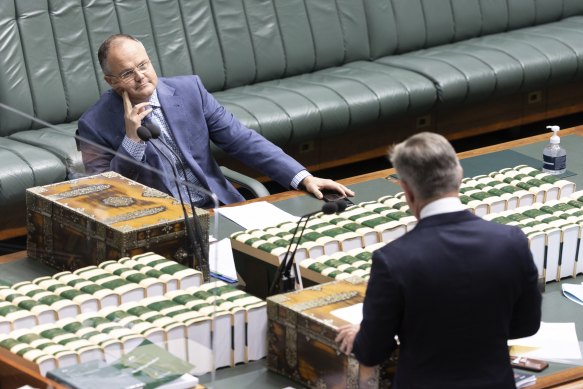- Exclusive
- Politics
- Federal
- Nuclear energy
This was published 9 months ago
Cash splash for nuclear towns under Coalition plan
By Paul Sakkal and Mike Foley
Regional communities will be showered with gifts for hosting nuclear reactors under Opposition Leader Peter Dutton’s energy policy, as the Coalition pledges a government-backed managed investment fund propped up by profits from its proposed power plants.
Opposition energy spokesman Ted O’Brien detailed the plans in a speech planned for this week’s Gippsland New Energy Conference, announcing the Coalition’s Community Partnership funds that invest dividends earned by the nuclear plants into the local economy.

Opposition energy spokesman Ted O’Brien listening to Climate Change and Energy Minister Chris Bowen.Credit: Alex Ellinghausen
Climate and Energy Minister Chris Bowen was invited to speak at the conference while O’Brien’s office claimed he was blocked from speaking despite the Coalition proposing a nuclear facility in the region, displaying what O’Brien called Australia’s “immature” energy debate that excludes nuclear energy advocates. Conference organisers were contacted for comment.
The Coalition’s signature energy policy would build seven taxpayer-funded, government-owned nuclear plants on the sites of existing coal generators. The proposed sites are in Lithgow and the Hunter Valley in NSW, Loy Yang in Victoria’s Latrobe Valley, Tarong and Callide in Queensland, Collie in Western Australia and Port Augusta in South Australia.
In his draft speech given to this masthead, O’Brien claimed the plants would supply the “cheapest electricity in the nation” for firms in industrial zones, which would attract a wave of investment to build facilities, grow the workforce and drive regional population growth.
“We want to ensure that communities like Latrobe can power Australian manufacturing for the remainder of this century and beyond,” O’Brien said in the speech.
“The key here is workers can move over in their same occupations, continuing to apply their skills, doing what they’ve always done. It means their social networks remain, their kids can still go to the same school.”
The Coalition has pledged to build the first two nuclear plants by 2037, with all seven completed by 2050. The sites have been selected to tap into existing transmission line infrastructure once the existing coal plants reach the end of their life.
However, experts have rejected claims that nuclear energy would be cheap, arguing renewables already produce less expensive electricity than fossil fuels and that CSIRO findings show it would cost more than $16 billion to build a single nuclear reactor.
The CSIRO said electricity will come from a grid drawing 90 per cent of its power from renewables, it would cost between $89 and $128 per megawatt hour by 2030. A large scale nuclear reactor would supply power for $136 to $226 per megawatt hour by 2040, according to the CSIRO.
The Coalition disputes the findings, saying the CSIRO did not consider the long life of nuclear plants, but has not released its own costings. This document will be key to understanding how the Coalition intends to return a profit on taxpayers’ investment in nuclear plants.
Bowen told the Gippsland conference on Wednesday the Coalition’s nuclear plan would cripple investment in renewable energy currently flowing to regional communities.
“They want to stop investment, stop jobs, and stop benefits in favour of waiting for a nuclear fantasy that may never come true,” he said.
The Coalition’s claims of a regional industrial boom under the nuclear plan resembles the goals of its previous regional investment policies.
The Inland Rail project was announced with an $8.4 billion cost by the Turnbull government in 2017 and spruiked as a scheme to attract investment to regional towns along the route. The project has blown out to more than $30 billion, with the Albanese government shelving plans to complete it.
The $5.4 billion Hells Gate dam on the Burdekin River in Far North Queensland was promised by the Morrison government in 2022, before a business case had been prepared and spruiked its potential to inject $1.3 billion into the local economy and create more than 7000 jobs. The project was abandoned after Labor formed government.
The Albanese government has also faced Coalition and economists’ criticism about its spending plans in new industries, particularly quantum computing and solar panel and battery manufacturing, through its $23 billion Future Made in Australia scheme.
Cut through the noise of federal politics with news, views and expert analysis. Subscribers can sign up to our weekly Inside Politics newsletter.